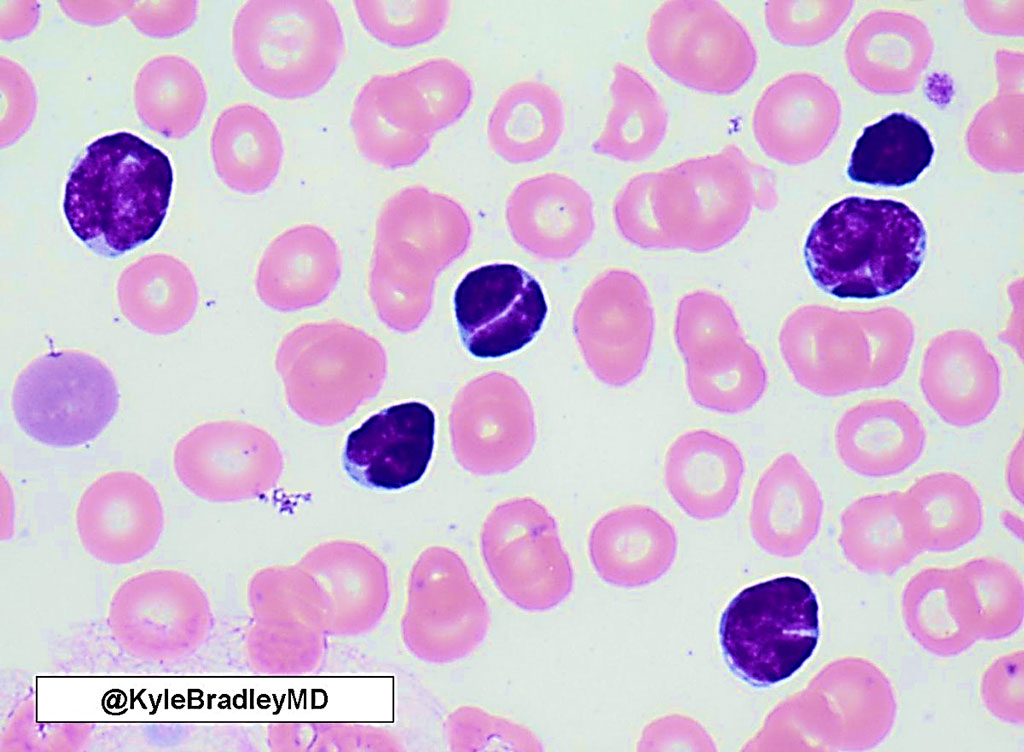Classification of Mature B-Cell Neoplasms Employing Standardized Flow Cytometry
By LabMedica International staff writers
Posted on 08 Dec 2021
The classification of lymphoid neoplasms integrates clinical, pathological, immunophenotypic, genetic, and molecular data in order to distinguish between mature B-cell lymphoma entities. The precise classification of these entities (also known as B-cell chronic lymphoproliferative diseases, B-CLPD) has relevant therapeutic implications.Posted on 08 Dec 2021
Immunophenotypic data combined with morphology, molecular, genetic, and clinical findings already contribute to the classification of mature B-cell neoplasms. Compared to other techniques, flow cytometry might be an advantageous method to assess the immunophenotype by virtue of its short turn-around time, its high dynamic range, its high sensitivity for rare cells, its potential for standardization and its world-wide availability.

Image: Blood smear from a patient with low grade follicular lymphoma in leukemic phase: note cleaved nuclei (coffee bean cells) and scant cytoplasm (Photo courtesy of Kyle Bradley, MD)
An International team of scientists led by those at the Rostock University Medical School (Rostock, Germany) studied 662 samples from an identical number of patients comprising of 145 chronic lymphocytic leukemia (CLL), 58 hairy cell leukemia (HCL), 29 Burkitt lymphoma (BL), 104 diffuse large B-cell (DLBCL), 129 follicular (FL), 74 lymphoplasmacytic (LPL), 76 mantle cell (MCL), and 47 marginal zone (MZL) lymphoma cases. In addition, 501 consecutive samples with a suspicion of lymphoma infiltration from 501 patients were acquired at two centers between March 14, 2020 and September 30, 2021.
The scientists used the EuroFlow 5-tube-8-color B-cell chronic lymphoproliferative disease antibody panel (EuroFlow, Leiden, The Netherlands). Expression levels of all 26 markers from the panel were plotted by B-cell entity to construct a univariate, fully standardized diagnostic reference library. For multivariate data analysis they subsequently utilized Canonical Correlation Analysis of 176 training cases to project the multi-dimensional space of all 26 immunophenotypic parameters into 36 two-dimensional plots for each possible pair-wise differential diagnosis. Diagnostic boundaries were fitted according to the distribution of the immunophenotypes of a given differential diagnosis. The team developed a diagnostic algorithm based on these projections was developed and subsequently validated using 486 independent cases.
The investigators reported that the negative predictive values exceeding 92.1% were observed for all disease categories except for follicular lymphoma. Particularly high positive predictive values were returned in chronic lymphocytic leukemia (99.1%), hairy cell leukemia (97.2%), follicular lymphoma (97.2%) and mantle cell lymphoma (95.4%). Burkitt and CD10+ diffuse large B-cell lymphomas were difficult to distinguish by the algorithm. A similar ambiguity was observed between marginal zone, lymphoplasmacytic, and CD10- diffuse large B-cell lymphomas. The specificity of the approach exceeded 98% for all entities.
The authors concluded that in summary, algorithm guided expert-independent flow cytometric classification of mature B cell neoplasms can contribute to a reliable diagnosis in the majority of these lymphomas. The method will very likely reduce inter-center variation at this particular diagnostic step and will objectively inform on the relative contribution of flow cytometric data to the integrated overall diagnosis of lymphoma entities. The study was published on November 23, 2021 in the journal Blood Advances.
Related Links:
Rostock University Medical School
EuroFlow













